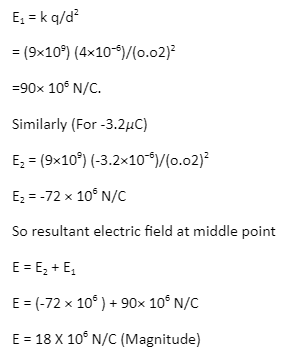The space or the surrounding in which the force of attraction and repulsion by the charges can be felt is called the electric field. A uniform electric field refers to the field having the same field strength throughout, and the field lines are equidistant and parallel to one another. The intensity of an electric field at a point due to a group of charges is equal to the arithmetic sum of intensities of an electric field due to each charge at the same given time. Let’s study an overview of the electric field due to a point charge example.
Electric Charge
Electric charge is the property of matter that governs how the particles of that matter behave in the presence of an electrical field. The charges can be of two types: positive or negative. The positive charge will attract the negative and repel the positive charge and vice versa. It is a scalar quantity (magnitude present but without direction), and its SI unit is Coulomb (C).
Example: When a glass rod is rubbed with a piece of silk, the glass rod will lose its electrons. On the other hand, the piece of silk will gain electrons. Thus, we can say that the rod will now be positively charged, whereas silk with extra electrons will be of negative charge.
When an electrically charged glass rod comes in contact with objects like bits of paper, it attracts them. It is because the rod acquires the property of attracting after being electrically charged.
Electric Field
The laws of Coulomb deal with the force that acts between two electric charges. This law is only applicable for a static (imbalanced) charge. The electric field is the production of motion of these charges, and it propagates through space at the speed of light. According to Coulomb’s law:
- The electric charges will modify its surroundings by forming an electric field around it.
- If we introduce a new charge in this region, that charge will experience some force that is due to the electric field produced by the previous charges.
Example of Electric Field Due to a Point Charge
Assume a point charge as ‘Q’ present at the origin O. This charge is placed in a vacuum. According to Coulomb’s law, if we place another point charge (say q) at a position (say P), if OP = r, then a force will be exerted by Q on the q charge. Thus, Q will produce an electric field around its surroundings, and this new charge q on point P will generate a force. Thus, the expression of the electric field produced at location r by charge Q will be as follows:

Solved Questions on Electric Field Due to a Point Charge
Q 1- State the magnitude of a point charge in an electric field. The point charges of 20μC were at a distance of 1m.
Solution
The formula for the calculation of the magnitude of an electric field due to a point charge will be as follows:

Q 2- Calculate the magnitude of an electric field at a point (in the middle of two charges). These 2 point charges are 4μC and -3.2μC, separated by a distance of 4 cm.
Solution
Assume the line that joins the charges is the x-axis. Therefore, we will find the electric field due to the charge at the midpoint (d = 2 cm).
The magnitude of the electric field will be as follows:


Q 3- Calculate both the magnitude and direction of an electric field at a point of 2 cm. It is left to the point charge of -2.4 nC.
Solution
For calculating the magnitude of an electric field due to point charge, we only require the absolute values (without any sign). Therefore, we can ignore the minus sign only while calculating the magnitude.

Direction: We can easily determine the direction of the electric field just by looking at the sign. In the given question, the charge is negative. Therefore, the direction of an electric field will be towards the charge.
Answer: The magnitude of this electric field will be 54× 10³ N/C, and its direction will be towards the charge.
Conclusion
The electric field is the force of either attraction or repulsion felt due to the force exerted by charges on its surroundings. Electric charge can be of two types: positive and negative. An example of electric charge is: When a glass rod is rubbed with a piece of silk, it will lose its electrons, and silk gains electrons, creating positive and negative charges, respectively. Coulomb’s law deals with the force present between these electric charges, and this law is only applicable for static charges. Coulomb’s law states that these electric charges will modify their surroundings by forming an electric field around them.
 Profile
Profile Settings
Settings Refer your friends
Refer your friends Sign out
Sign out






